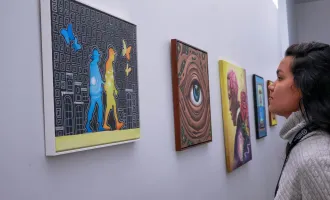
Film Investigates CRISPR Evolution
“We’ve never had the ability to change the fundamental chemical nature of who we are, and now we do.”
This is how Dr. Jennifer Doudna described the discovery of CRISPR in the upcoming movie Human Nature, a science documentary about what has been called molecular biology’s “holy grail.”
On Feb. 3, UCSF community members filled Genentech Hall to watch an exclusive pre-screening of Human Nature, the first feature length film produced and directed by Wonder Collaborative at the UCSF-affiliated nonprofit iBiology.
Dr. Sarah Goodwin, who joined iBiology after getting her PhD in cell biology at UCSF, was a producer and leading science advisor on the project.
She was on hand to introduce the movie, which she called “an experiment in scientific storytelling.”
The first question Human Nature tries to answer is “What is CRISPR?”
Across interviews with a range of academic and industry scientists, the movie considers CRISPR’s biological origins as well as its initial discovery in yogurt.
Like many modern biology tools, CRISPR is a repurposed piece of nature.
Though today recognized for its enormous potential, CRISPR was first noticed by yogurt company Danisco as “peculiar sequences” that appeared in bacteria resistant to viral infection.
The so-called “Clustered Regularly Interspaced Short Palindromic Repeats” caught researchers’ attention when they realized that the “spacer” DNA between the repeats sometimes looked identical to parts of viral DNA.
As the movie describes it, these spacer DNA sequences were being used like wanted posters for viruses.
Bacteria created copies of the viral DNA as wanted posters, which were then used to hunt down the viruses and cut apart their genomes.
This explained why some bacteria had survived the viral infection — they were using CRISPR to seek viruses and cut into them.
Eventually, scientists realized that this ability to find and cut specific DNA was the tool
they had been waiting for.
It could be used more broadly to specifically edit DNA in an unprecedented way, almost as easily as editing a computer document.
Understandably, perhaps, Human Nature does not dwell on the scuffles that emerged over patenting CRISPR.
In 2012, Doudna and collaborators proved that CRISPR could be used to cut pure DNA in a test tube. Then, in 2014, Dr. Feng Zhang used CRISPR to edit human cells’ DNA in the petri dish.
The University of California and the Broad Institute both filed patents on CRISPR technology and began the complex legal back-and-forth over whether these two uses of CRISPR represented separate or interfering claims.
Since then, dozens of patents have been filed for CRISPR and its offshoots in the US and Europe.
Instead, the film’s second half investigates the thorny ethical issues this discovery has created as humans begin to edit their own DNA.
Interweaving interviews with patients, patient families, genetic counselors, entrepreneurs, and bioethicists, the film brings up a broad range of perspectives on CRISPR use for human health.
A major topic was whether CRISPR will be limited to particular therapies. One option is to use CRISPR only in treating individual patients, for example editing a patient’s sick blood cells and transfusing the healthy cells back in.
Others hope that CRISPR will be used more liberally to edit a person’s germline.
The germline consists of eggs and sperm, so editing these with CRISPR would produce changes not only in someone’s children but in their grandchildren and all future descendants.
Germline edits are a chance for some to have children without fear of passing on their genes for known diseases, especially incurable fatal or chronic conditions.
Still, it is difficult to predict how editing the germline freely might affect humankind.
If scientists found a gene to let humans thrive on only five hours of sleep a night, would there be pressure to edit all children’s genes?
Even more difficult is predicting side effects of CRISPR, since gene functions are complicated and often incompletely understood.
In the panel discussion after the screening, experts weighed in on CRISPR’s therapeutic uses and predicted how this could impact our healthcare and our genomes.
UCSF Bioethics director Professor Barbara Koenig noted that the old approach to these technologies limited use to treatment of disease.
“But what is a disease and what isn’t… is an enormously complicated concept,” she said.
UC Berkeley Professor Fyodor Urnov hoped there would simply be far more positive CRISPR applications that outweighed the ethical dilemmas of issues like designer babies.
He gave the example of Victoria Grey, a patient with sickle cell disease who volunteered in 2019 to receive an experimental CRISPR treatment and seems to have been cured.
In one scene of Human Nature, the camera advances toward four large tinted chemical bottles. The bottles are marked with the letters “A,” “C,” “G,” “T/U,” and they contain the chemicals that make up genetic material and enable CRISPR to make its groundbreaking gene edits.
The implication was clear: No one can put the genie back in the bottle — CRISPR technology is here to stay.
As Professor Keith Yamamoto said after the screening, “[W]e can’t go back to not knowing about DNA.”
Human Nature is scheduled for release in select US theaters on March 13.



